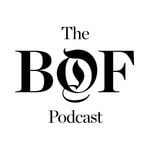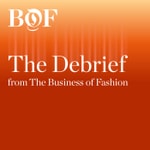The Business of Fashion Podcast – Détails, épisodes et analyse
Détails du podcast
Informations techniques et générales issues du flux RSS du podcast.

The Business of Fashion Podcast
The Business of Fashion
Fréquence : 1 épisode/5j. Total Éps: 550

Hosted on Acast. See acast.com/privacy for more information.
Classements récents
Dernières positions dans les classements Apple Podcasts et Spotify.
Apple Podcasts
🇨🇦 Canada - fashionAndBeauty
28/07/2025#11🇬🇧 Grande Bretagne - fashionAndBeauty
28/07/2025#7🇬🇧 Grande Bretagne - arts
28/07/2025#67🇩🇪 Allemagne - fashionAndBeauty
28/07/2025#5🇩🇪 Allemagne - arts
28/07/2025#70🇺🇸 États-Unis - fashionAndBeauty
28/07/2025#11🇺🇸 États-Unis - arts
28/07/2025#85🇫🇷 France - fashionAndBeauty
28/07/2025#14🇨🇦 Canada - fashionAndBeauty
27/07/2025#6🇨🇦 Canada - arts
27/07/2025#72
Spotify
🇬🇧 Grande Bretagne - arts
12/07/2025#50↗🇬🇧 Grande Bretagne - arts
20/06/2025#47↘🇬🇧 Grande Bretagne - arts
19/06/2025#44↗🇬🇧 Grande Bretagne - arts
18/06/2025#45↘🇬🇧 Grande Bretagne - arts
17/06/2025#42↘🇬🇧 Grande Bretagne - arts
16/06/2025#40↘🇬🇧 Grande Bretagne - arts
15/06/2025#38↗🇬🇧 Grande Bretagne - arts
14/06/2025#39↘🇬🇧 Grande Bretagne - arts
13/06/2025#38↗🇬🇧 Grande Bretagne - arts
12/06/2025#39↘
Liens partagés entre épisodes et podcasts
Liens présents dans les descriptions d'épisodes et autres podcasts les utilisant également.
See all- https://www.instagram.com/p
11467 partages
Qualité et score du flux RSS
Évaluation technique de la qualité et de la structure du flux RSS.
See allScore global : 58%
Historique des publications
Répartition mensuelle des publications d'épisodes au fil des années.
Kamala Harris and the Politics of Style
vendredi 30 août 2024 • Durée 32:22
As the first female, Black, and South Asian Vice President of the United States, Kamala Harris’s every move is closely watched — from her policy decisions to her wardrobe. With Harris now leading the Democratic ticket in the 2024 presidential election, her style and beauty choices — from her for her sleek silk press hairstyle to her endless variety of pantsuits — have sparked renewed discussion.
“She is communicating something, even if it's not remarkable,” said BoF senior correspondent Sheena Butler-Young. “No one truly opts out of signalling something with how they present themselves.”
This week on The Debrief, BoF executive editor Brian Baskin sat down with Butler-Young and editorial apprentice Yola Mzizi to explore how Harris’s beauty and fashion choices are being interpreted by different audiences across the political spectrum, and what that means for the future of political style.
Key Insights:
- Harris’s signature silk-pressed hairstyle has deep roots. “It's a centuries old way of straightening hair, and it's been around for generations upon generations. Most people associate it with just the hair that they have to have for Easter Sunday, or the style that the grandmothers would have,” Mzizi explains. Despite the history, Black Gen-Z voters have embraced the style, calling it the presidential silk press. “It's a way to support her candidacy in a fun way,” said Mzizi.
- Harris’ wardrobe choices are being closely scrutinised, which has led her to more streamlined, straightforward ensembles. “The pantsuits, specifically the colour schemes — black, grey, navy blue, or just blues, with an occasional pastel, a pump as the shoe, or occasional Converse and pearls — are very much in line with how politicians dress,” said Butler-Young. Meanwhile, male politicians, like Harris’s vice-presidential nominee, Minnesota Governor Tim Walz, have more freedom to experiment. “You look at her running mate Tim Walz, and his ability to sort of play around with style with those well-worn red wing boots, the camouflage hats, rather than being distracting, they actually endear some voters to him. … Kamala, for all intents and purposes, doesn't seem to have the licence to do that.”
- The 2024 election has highlighted the growing role of fashion and beauty in politics. Black-owned beauty brand BLK/OPL was centre stage at the DNC providing makeup services as the event’s first beauty sponsor. “Harris's candidacy is opening up new avenues for different kinds of brands to have their say in this larger conversation,” Mzizi notes.
- Should Harris win the presidency, she could use her platform to further influence the intersection of fashion and politics. Harris has already hinted at this with her past choices by wearing Black designers like Christopher John Rogers and Sergio Hudson. “She'll have more leeway to [support minority designers] when she's empowered. Right now, I think she's constrained … by this idea of having to cater to this broad, collective public palette.”
Additional resources
- How Kamala Harris’ Signature Tresses Became a Gen-Z Hit | BoF
- Why Kamala Harris Isn’t Making Bold Fashion Choices – Yet | BoF
Hosted on Acast. See acast.com/privacy for more information.
How Tweens Took Over the Beauty Aisle
vendredi 23 août 2024 • Durée 34:24
2024 has brought forth the arrival of the “Sephora tweens,” which refers to members of Gen Alpha (roughly defined as those born between 2010 and 2024) who have enthusiastically taken to buying up skincare and makeup. This phenomenon, driven largely by beauty-related chatter on social media, has resulted in a new wave of brands catering specifically to this younger demographic.
“There are now teen brands, tween brands, 20-something brands, 30-something brands. … I think we can thank the DTC movement and everything that happened from 2014 on for this kind of innovation,” Rao says. “There's been a total disruption in beauty overall with challenger brands like Glossier that have come and really taken market share away from the big conglomerates and companies … that have been household names for a really long time.”
This week on The BoF Podcast, senior correspondent Sheena Butler-Young and executive editor Brian Baskin sat down with Priya Rao, executive editor at The Business of Beauty at BoF, to delve into how tweens have taken over the beauty aisle and what this means for the future of the industry.
Key Insights
- Kids have long experimented with beauty products, but today, they’re starting earlier and earlier. "If you look at social media today, it's not just 10-year-olds or 11-year-olds. There are 5- and 6-year-olds putting on makeup and trying different lipsticks and lip glosses," shared Rao. This early engagement with beauty is not just a passing trend, but is becoming a norm, fueled by the accessibility of products to try in stores like Sephora and the influence of social media platforms like TikTok.
- Another driving force behind this trend is the rise of celebrity-led beauty brands that resonate with young people. For example, Rare Beauty, founded by Selena Gomez, not only offers products but also promotes mental health awareness. "Tweens and teens can identify with these brands not just because of the products, but because of what they stand for," explained Rao.
- The proliferation of skincare products has also led to some confusion and concern, with tweens using products like retinol that are meant for an older demographic. Brands and influencers play a crucial role in teaching young consumers what’s right for their skin. "Fear is not the way to lead here. It's about education first," advised Rao. Brands must strike a balance between engaging young consumers without overwhelming them with too many steps or products.
- As the beauty industry continues to evolve, brands that wish to stay ahead will need to be responsive to the needs of Gen-Z and Gen Alpha consumers. "Smart companies have to be agile and constantly communicate with their customers," noted Rao. This means reflecting the diverse experiences of young consumers back to them, whether through representation in ad campaigns or through the products themselves.
Additional resources
- How Tweens Took Over the Beauty Aisle | BoF
- How Should We Feel About Tweens at Sephora? | BoF
- Tweens Obsessed With Skin Care Drive Brands to Say: Don’t Buy Our Stuff
Hosted on Acast. See acast.com/privacy for more information.
Deena Aljuhani Abdulaziz on Redefining Arab Fashion Media
vendredi 21 juin 2024 • Durée 40:52
Deena Aljuhani Abdulaziz was drawn to fashion from a young age, devouring issues of Vogue and Tatler. This led her to set up D’NA, a members-only boutique based in Saudi Arabia and Qatar. 10 years later when she closed her boutique, she became the founding editor in chief of Vogue Arabia – but soon parted ways with the publication due to a misalignment in values.
Now, Aljuhani Abdulaziz is back with her own media publication, on her own terms. ‘Deenathe1st.com’ is an editorial lifestyle website dedicated to fostering a creative community that celebrates Arab culture.
“What I hold dear is what anybody would hold dear. Representing my culture correctly and fairly,” she says. “And it's not trying to show off Western ideas to the region. It's the other way around. It's showcasing the region and what we share creatively with the rest of the world.”
This week on The BoF Podcast, Aljuhani Abdulaziz joins BoF founder and editor-in-chief Imran Amed to share her career journey, the lessons she’s learned about fostering culture and community, and why the fashion community needs a new publication.
Key Insights
- Born in California but raised between the US and Saudi Arabia, Aljuhani Abdulaziz is an expert code switcher who’s always felt able to act like a cultural bridge between the two worlds. “It never felt like an effort. It just came naturally. I think that's part of what makes me who I am in a sense,” she shares. “It's not just in figures of speech, but also in how you would interact with people, because there are different customs and traditions in different regions and in different households. It's really about a state of mind.”
- Aljuhani Abdulaziz’s first fashion influence was her mother, who she describes as “still very, very chic.” As a child, her discovery of Tatler magazine pushed this passion even further. “I picked it up and I opened up its pages and I was like, ‘Oh my goodness, this is it!’ I was just so grateful and happy that it existed.”
- Aljuhani Abdulaziz’s stint at Vogue Arabia ended abruptly after just two months. “I understood the responsibility of being a voice for a very big region, being Arab myself,” she said. “I think there was a point when that didn't align and the visions were not parallel.”
- Looking to the future, Aljuhani Abdulaziz says she is building her editorial lifestyle platform ‘Deenathe1st.com’ on the basis of community, shared values, and kindness. “I think that it's super important to remind people that you don't have to be nasty to be stylish or to be in fashion or to be chic,” she said. “I would love to continue my love letter to Arabia. That's really what I'm trying to do with this site.”
Additional resources
- Deena Aljuhani Abdulaziz Exits Vogue Arabia | BoF
- Vogue Arabia Appoints Manuel Arnaut as Editor-in-Chief | BoF
- A New Era of Arab-Led Fashion Media | BoF
Hosted on Acast. See acast.com/privacy for more information.
The Debrief: How Big Brands Choose Their Creative Directors
vendredi 23 septembre 2022 • Durée 23:43
Louis Vuitton is expected to name its Virgil Abloh successor within weeks. Lauren Sherman quizzes Imran Amed on what luxury labels think about when recruiting top designers.
Background:Louis Vuitton has spent almost a year searching for a Virgil Abloh successor after the designer died in November 2021. According to sources, Martine Rose, Grace Wales Bonner and Telfar Clemens are among the names that were considered by owner LVMH, and the decision is expected to be announced within weeks. But how do brands like Louis Vuitton even go about finding a designer?
“Without the creative energy, without that kind of excitement, there’s nothing to sell,” said Imran Amed, BoF founder and editor-in-chief.
Key Insights:- While all brands have their own personality and the situations that necessitate finding a new creative director differ, the things most brands look for in a leader are similar.
- Executives have to consider whether they’re looking for revolution, like when Gucci tapped Alessandro Michele for creative energy and new ideas, or evolution, like when Saint Laurent tapped Anthony Vaccarello to keep its aesthetic formula after Hedi Slimane departed.
- A strong vision is the most important thing. But creative directors also need to have commercial sensibility and the ability to work in a corporate environment.
- One of Abloh’s achievements was that he managed to build a community at Louis Vuitton, and engage consumers who had been traditionally excluded by the luxury industry.
- Virgil Abloh: Building on a Legacy: Like Yves Saint Laurent, Alexander McQueen and Gianni Versace before him, the late Virgil Abloh leaves a powerful legacy. What does this mean for Off-White and Louis Vuitton?
- Which Luxury Leadership Configuration Works Best? In luxury fashion, the right configuration of creative and commercial leadership is critical to success, writes Pierre Mallevays.
To subscribe to the BoF Podcast, please follow this link.
Hosted on Acast. See acast.com/privacy for more information.
Queen Elizabeth II’s Leadership and Legacy
vendredi 16 septembre 2022 • Durée 22:08
Royal expert Elizabeth Holmes speaks to BoF’s Imran Amed about Queen Elizabeth II’s life and legacy — in fashion, culture and society at large.
Background:
Tributes to Britain’s longest-reigning monarch have flooded social media, television and even public parks in the days since her passing, memorialising the Queen’s steadfast leadership, but also her impeccable sense of style.
This week on The BoF Podcast, BoF’s founder and editor-in-chief Imran Amed speaks with royal expert Elizabeth Holmes who reflects on the influence the Queen’s record-setting reign has had on the fashion industry and the wider culture.
Key Insights:
- The Queen was known around the world for her monochromatic outfits, designed to help her stand out in the crowd. She also created a unique twist on a set formula of basics: hat, coat, bag and pearls. “I think she understood the power of clothes,” says Holmes. “She used things like the colour of her outfit, especially when she was travelling overseas to perhaps match the host country's flag.”
- Holmes details how the Queen had a “tremendous sort of swing of the style pendulum” from her private life, where she’d wear headscarves and tartan skirts, to her public life, wearing tiaras and gowns. “It was very important to see all aspects of royal life,” says Holmes. “Both being worthy of the glamour of royalty, but then also sensible stewards of taxpayer dollars.”
- Her influence also stretched outside of her sovereign powers, with the path she paved for other female leaders around the world. Being crowned Queen at just 25, she became one of the only women at the table of leadership, and she made it count. “I think the Queen sort of made it permissible to really stand out.”
- As King Charles III takes to the throne commentators are looking to the future of the institution. “The conversation changes a little bit now that there is a King on the throne,” says Holmes. “Understanding that the whole spotlight shifts to him and with that, the good and perhaps the criticism, too.”
Additional Resources:
- Queen Elizabeth II’s Style Legacy: Britain’s longest reigning monarch has died. Her influence extended to the realm of fashion, where she invented the concept of “sartorial diplomacy.”
- What the Queen Means to Designers: Queen Elizabeth was an inspiration for fashion designers from Vivienne Westwood to Alessandro Michele to Richard Quinn. Will any British royal have the same influence again?
Hosted on Acast. See acast.com/privacy for more information.
Casablanca’s Charaf Tajer on Designing for Impossible Possibilities
vendredi 9 septembre 2022 • Durée 45:24
The designer speaks with BoF’s founder and editor-in-chief Imran Amed about building his own business, the power of aspiration and opening doors for people who want to break into fashion.
Background:
French-Moroccan designer Charaf Tajer is the French-Moroccan designer behind Casablanca, a business that he started with only €3,000 to tap into the growing demand for women’s resortwear, and which is now doing more than €45 million in annual revenue.
But Charaf’s rise in the Parisian fashion scene is also exceptional because of who Charaf is and where he is from. As one of the few people of colour working at the very top level of French luxury fashion, he has learned that no matter how high his star rises, he still faces discrimination related to his identity as he travels in these elite spaces. This only makes him want to work harder to break down barriers and become a role model.
On the latest episode of the BoF Podcast, designer Tajer joins BoF’s Imran Amed on The BoF Podcast to talk about building his own business, the power of aspiration and opening doors for people who want to break into fashion.
Key Insights:
- Growing up in the outskirts of Paris, Tajer had an early appreciation for luxury, getting glimpses of wealth going with his mother to work as a cleaner in the 16th arrondissement. He channelled this sense of curiosity into the core of Casablanca and believes it lies in the industry itself. “I think this is what fashion does, is like it opens a certain option of dreaming of certain things,” says Tajer.
- Tajer believes you must go outside of your comfort zone and explore new paths to achieve success. “There is nothing for you in the past, so you have to go to the future because when you look back, there’s nothing for you… There was no space for me to grow.”
- Tajer’s background has at times led him to feel like a fashion outsider. That feeling inspired him to want to become a role model for others. “Beside the fact that I’m a North African Muslim guy, I also just want to represent the new face of France,” says Tajer. “It’s my duty to also accomplish the biggest thing in the world, to become an example.”
- While entering the world of fashion, Tajer is careful to open doors for others and leave behind a legacy that any achievement is possible with effort. “For me I only want to go for the impossible possibilities,” Tajer says.
Additional Resources:
- Fashion’s Top M&A Targets: The market may be cooling, but a number of in-demand brands remain of interest to financial backers. BoF identifies the top targets.
- Can Fashion Start-Ups Cash In on the Tennis Boom? For a new wave of tennis-inflected fashion start-ups, success may depend on balancing the energy of the sport’s increasingly inclusive present with the allure of its exclusive past.
Hosted on Acast. See acast.com/privacy for more information.
Rick Owens on Lessons Learned from the Pandemic
vendredi 2 septembre 2022 • Durée 57:14
The designer speaks with BoF editor-at-large Tim Blanks about his first collection after 2020 and why he feels a sense of optimism following the pandemic.
Background:
At the start of 2021, Rick Owens wanted his next show to reflect the universal toll the pandemic had taken on the world. Held at Venice’s Tempio Votivo, a shrine to the fallen soldiers of the two world wars, Owens centred the show around the sombre themes of “anger and darkness.” Despite this ominous outlook, Owens told BoF editor-at-large Tim Blanks in January 2021 that a pivot in political circumstances with the inauguration of Joe Biden gave him a sense of optimism.
On this week’s episode of the BoF Podcast, we revisit this thought provoking conversation with Owens about his Autumn/Winter 2021 collection, his reflections on lessons learned from the pandemic and his renewed hope for society.
Key Insights:
- For Owens, constraints can create fertile ground for creativity. “It has been quiet change and I like the idea of working within small boundaries,” says Owen. “I like the idea of doing the best with what you have got.”
- Owens created his collection when the world was facing growing political uncertainty and instability but he says “one of the most reassuring things [in this world] is that everything usually balances out. We have survived this long because there is just a tiny bit more of goodness than badness. Just enough to keep us surviving.”
- Owen’s men’s shows in particular are deeply personal. “My men’s runway shows are always about men’s flaws and men’s worst urges because they are auto-biographical,” he says. “When I am thinking about men I am thinking about my own experience and my own experience is very critical and I am always very conscious of my worst urges and where they are coming from.”
Additional Resources:
- Rick Owens: Control and Abandon
- Tim Blanks’ Top Fashion Shows of All-Time: Rick Owens Spring/Summer 2014, September 26, 2013
- What Fashion Wants From a Biden Presidency
Hosted on Acast. See acast.com/privacy for more information.
Inside Yohji Yamamoto’s Fashion Philosophy
vendredi 26 août 2022 • Durée 40:53
In a rare interview, the influential Japanese designer speaks with BoF’s Imran Amed about the philosophy that underpins his boundary-breaking career.
Background:
After graduating from Keio University with a law degree, Yohji Yamamoto realised he wasn’t interested in the law.
“I didn’t want to join the ordinary society,” he says. “So I told my mother after graduation … ‘I want to help you.’”
She agreed to let him work at her dressmaking shop in Kabukicho, an entertainment district in Tokyo’s Shinjuku ward, and learn from the sewing assistants if he enrolled at Bunka Fashion College, now famous for training designers such as Kenzo Takada, Junya Watanabe and Yamamoto himself.
After graduating, Yamamoto went on to set up a small ready-to-wear company that slowly acquired buyers in all of Japan’s major cities. This success eventually led him to Paris, where his signature tailoring and draping in oversized silhouettes created an aesthetic earthquake at Paris Fashion Week in 1981.
Since then, Yamamoto has developed a cult following of loyalists who swear by his avant-garde designs. “I’m not working in the mainstream,” he says. “I’m working in the side stream.”
This week on The BoF Podcast, we revisit Imran Amed’s rare interview with the legendary Japanese designer about his storied career — and the mindset designers need to succeed.
Key Insights:
- Yamamoto says the fashion industry’s increasingly fast-pace has come at the expense of true creativity. “For me the fashion business became a money business,” he said. “I felt I’ve been losing my competitors year by year.”
- Yamamoto believes that modern technology can be a distraction. “When I speak with young designers, I [tell] them shut your computer,” he said. “If you really want to see real things, real beauty, you have to go there by walking.”
- Yamamoto believes it’s a designer’s job to completely immerse themselves in design. “If you want to create something, keep resisting the mediocracy of ordinary things. It’s a life's work. Are you ready to sacrifice yourself to create something?”
Additional Resources:
- Watch the full interview here: Inside Yohji Yamamoto’s Fashion Philosophy
- The Magic of Yohji Yamamoto
Hosted on Acast. See acast.com/privacy for more information.
The Debrief: Department Stores Make a Comeback
jeudi 18 août 2022 • Durée 22:54
After a pandemic pivot to e-commerce, many brands are back to working with third-party retailers, this time, with better terms.
Background:
The wholesale model, while offering exposure and some upfront revenue, did not always have the best terms for vendors. Department store bankruptcies, pandemic-induced store closures and the boom in online shopping pushed brands further towards their direct-to-consumer and e-commerce businesses to drive revenue.
But that’s beginning to change. As shoppers return to stores, brands are seeing value in ramping up their partnerships with multi-brand retailers — this time on better terms. “What I'm hearing across the board from both brands and retailers is that this vendor-retailer relationship is more collaborative than ever,” said BoF retail correspondent Cathaleen Chen.
Key Insights:
- There are multiple factors pushing brands back to wholesale. Among them, the growth of e-commerce, which has slowed after spiking in 2020, and the growing consumer appetite for curated, in-person shopping experiences that allow them to stumble upon new designers. “That discovery is still so important, and now [shoppers are] relying on a cool third-party retailer to sort of facilitate that discovery,” said Chen.
- “Wholesale is very American,” noted Chen, making it an attractive vehicle for international labels looking to enter the lucrative US market.
- Brands are having more of a say over how their products are marketed through retailers, like sharing campaign assets or designing shop-in-shop setups.
- Both parties are also increasingly open to exploring other models like concession, consignment — more typical to European department stores — and drop-shipping, where the brands themselves are responsible for fulfilling orders made through retailer’s websites.
- Brands are returning to wholesale, but not at the expense of their direct-to-consumer and retail offerings. “I think we're at a point where everybody has a more well-rounded business so that if things do go bad again in whichever channel, they can be agile and adapt very quickly,” said Chen.
Additional resources:
- How to Take a Brand From Local to Global | BoF
- Searching for the Next Barneys
- Inside Neiman Marcus' Post-Bankruptcy Playbook
Follow The Debrief wherever you listen to podcasts.
To subscribe to the BoF Podcast, please follow this link.
Hosted on Acast. See acast.com/privacy for more information.
Serena Williams: "Pressure is a Privilege"
vendredi 12 août 2022 • Durée 30:23
Revisiting a conversation with BoF’s Imran Amed from 2019, the 23 grand slam winning tennis champion, who announced her retirement this week, talks about how the mental toughness she has built on the court has prepared her for life as an entrepreneur.
Background:
This week, tennis superstar Serena Williams announced her imminent retirement as part of a cover story with American Vogue. Known in fashion circles for her on-court style, which included catsuits and denim skirts and a collaboration with late designer Virgil Abloh’s Off-White, Williams will have more time to focus on as her burgeoning business empire, including her fashion label S by Serena and a venture fund, Serena Ventures.
This week on The BoF Podcast, we revisit Williams’ 2019 conversation with BoF founder and editor-in-chief Imran Amed about how the mental toughness she has built on the court has prepared her for life as an entrepreneur.
“It's really important for things not to come super easy for you, and to kind of accept that challenge, embrace it and then just roll with it,” said Williams.
Key Insights:
- Rather than work with a partner, licence her name or sign another lucrative endorsement, Williams felt it was important to invest time, money and effort in herself and chase her own vision with S by Serena, a direct-to-consumer brand she has funded independently.
- Serena Ventures just raised $111 million and has invested in over 60 companies including personal care brand Lola, supply chain management firm Calico and razor-maker Billie.
- The fund was originally founded in 2014 when Williams noticed people of colour and women were not getting the investments they needed.
- Balancing all her pursuits and personal life can be tough. But, when she feels pinched, William is reminded of one of her favourite quotes from Billie Jean King: “pressure is a privilege.”
Additional Resources:
- Serena Williams: The Champion’s Mindset
- Serena Williams, Style Icon, Retiring From Tennis
- How Athletes Went From Selling Merch to Building Fashion Brands
Hosted on Acast. See acast.com/privacy for more information.









